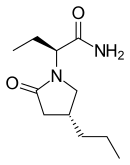Brivaracetam
Brivaracetam (trade name Briviact), a chemical analog of levetiracetam, is a racetam derivative with anticonvulsant (antiepileptic) properties.[2][3] It is marketed by the pharmaceutical company UCB.[4][5] In India it is co-promoted and distributed by Dr. Reddy's Laboratories.
 | |
| Clinical data | |
|---|---|
| Pronunciation | /ˌbrɪvəˈræsətəm/ BRIV-ə-RASS-ə-təm |
| Trade names | Briviact |
| AHFS/Drugs.com | Monograph |
| MedlinePlus | a616027 |
| License data |
|
| Pregnancy category |
|
| Routes of administration | Oral (tablets, oral solution), IV |
| ATC code | |
| Legal status | |
| Legal status |
|
| Pharmacokinetic data | |
| Bioavailability | Nearly 100% |
| Protein binding | ≤20% |
| Metabolism | Hydrolysis by amidase, CYP2C19-mediated hydroxylation |
| Metabolites | 3 inactive metabolites |
| Elimination half-life | ≈9 hours |
| Excretion | Kidneys (>95%)[1] |
| Identifiers | |
| |
| CAS Number |
|
| PubChem CID | |
| ChemSpider | |
| UNII | |
| KEGG | |
| ChEBI | |
| ChEMBL | |
| CompTox Dashboard (EPA) | |
| ECHA InfoCard | 100.118.642 |
| Chemical and physical data | |
| Formula | C11H20N2O2 |
| Molar mass | 212.293 g·mol−1 |
| 3D model (JSmol) | |
| Specific rotation | [α]D −60° |
| Melting point | 72 to 77 °C (162 to 171 °F) |
| |
| |
Medical uses
Brivaracetam is used to treat partial-onset seizures with or without secondary generalisation, in combination with other antiepileptic drugs. No data are available for its effectiveness and safety in patients younger than 16 years.[6][7]
It is sometimes prescribed as an alternative to the drug's analogue levetiracetam to avoid neuropsychiatric adverse effects such as mood swings, anxiety, emotional lability, and depression.
Adverse effects
The most common adverse effects include sleepiness, dizziness, nausea and vomiting. More rarely, coordination problems and changes in behaviour can occur.[6][7]
Interactions
Coadministration of brivaracetam with carbamazepine may increase exposure to carbamazepine-epoxide, the active metabolite of carbamazepine, and could theoretically lead to reduced tolerability. Coadministration of brivaracetam with phenytoin may increase phenytoin levels. Coadministration of other antiseizure drugs are unlikely to affect brivaracetam exposure. Brivaracetam provides no added therapeutic benefit when administered in conjunction with levetiracetam that acts on the same protein.[8]
Pharmacology
Mechanism of action
Brivaracetam is believed to act by binding to the ubiquitous synaptic vesicle glycoprotein 2A (SV2A), like levetiracetam. but with 20-fold greater affinity.[9][10] There is some evidence that racetams including levetiracetam and brivaracetam access the luminal side of recycling synaptic vesicles during vesicular endocytosis. They may reduce excitatory neurotransmitter release and enhance synaptic depression during trains of high-frequency activity, such as is believed to occur during epileptic activity. [11]
Pharmacokinetics
Brivaracetam exhibits linear pharmacokinetics over a wide dose range, is rapidly and completely absorbed after oral administration, has an elimination half-life of seven to eight hours, and has plasma protein binding of less than 20%. It is extensively metabolized (>90%), primarily via hydrolysis of the acetamide group, and secondarily through hydroxylation mediated by the liver enzyme CYP2C19. The three major metabolites (hydroxy, acid, and hydroxyacid) are pharmacologically inactive. Brivaracetam is eliminated as urinary metabolites, with over 95% of a radioactive test dose recovered in the urine within 72 hours, including only 8.6% as unchanged brivaracetam.[12]
Pharmacogenetics
As noted above, brivaracetam is primarily metabolized by hydrolysis, via amidase enzymes, to an inactive metabolite. To a lesser extent, it is also metabolized by a minor metabolic pathway via CYP2C19-dependent hydroxylation. Individuals who have no CYP2C19 enzyme activity, "CYP2C19 poor metabolizers", will have a greater exposure to standard doses of brivaracetam. Because they are less able to metabolize the drug to its inactive form for excretion, they may have an increased risk of adverse effects. The most common adverse effects of brivaracetam therapy include sedation, fatigue, dizziness, and nausea.[13] The FDA-approved drug label for brivaracetam states that patients who are CYPC19 poor metabolizers, or are taking medicines that inhibit CYP2C19, may require a dose reduction.[14]
Chemical and physical properties

Brivaracetam is the 4R-propyl analogue of the anticonvulsant levetiracetam.
History
Positive preliminary results from stage III trials were recorded in 2008,[15] along with evidence that it is around ten times more potent for the prevention of certain types of seizure in mouse models than its analogue levetiracetam.[16]
On 14 January 2016, the European Commission,[7] and on 12 May 2016, the U.S. Food and Drug Administration (FDA)[17] approved brivaracetam under the trade name Briviact. The Drug Enforcement Administration (DEA) issued an interim final rule placing brivaracetam into schedule V of the Controlled Substances Act (CSA) effective 9 March 2017.[18] As of May 2016, brivaracetam is not approved in some other countries, such as Switzerland. It was approved in Australia in August 2016.[19] In Canada it was approved on 9 March 2016 under the trade name Brivlera.[20]
Legality
Australia
Brivaracetam is a schedule 4 substance in Australia under the Poisons Standard (February 2020).[21] A schedule 4 substance is classified as "Prescription Only Medicine, or Prescription Animal Remedy – Substances, the use or supply of which should be by or on the order of persons permitted by State or Territory legislation to prescribe and should be available from a pharmacist on prescription." [21]
References
- "Briviact (brivaracetam) Tablets, for Oral Use; Oral Solution; Injection, for Intravenous Use. CV. Full Prescribing Information" (PDF). UCB, Inc., Smyrna, GA 30080. Retrieved 27 August 2016.
- von Rosenstiel P (January 2007). "Brivaracetam (UCB 34714)". Neurotherapeutics. 4 (1): 84–7. doi:10.1016/j.nurt.2006.11.004. PMID 17199019.
- Malawska B, Kulig K (July 2005). "Brivaracetam UCB". Current Opinion in Investigational Drugs. 6 (7): 740–746. PMID 16044671.
- "Briviact Product Page". UCB. Retrieved 1 January 2020.
- "Brivaracetam". DrugBank. Retrieved 1 January 2020.
- Drugs.com: briviact for Briviact.
- "Briviact". European Medicines Agency. Retrieved 30 May 2016.
- Rolan P, Sargentini-Maier ML, Pigeolet E, Stockis A (2008). "The pharmacokinetics, CNS pharmacodynamics and adverse event profile of brivaracetam after multiple increasing oral doses in healthy men". Br J Clin Pharmacol. 66 (1): 71–5. doi:10.1111/j.1365-2125.2008.03158.x. PMC 2485265. PMID 18341673.
- Rogawski MA, Bazil CW (July 2008). "New molecular targets for antiepileptic drugs: alpha(2)delta, SV2A, and K(v)7/KCNQ/M potassium channels". Current Neurology and Neuroscience Reports. 8 (4): 345–352. doi:10.1007/s11910-008-0053-7. PMC 2587091. PMID 18590620.
- Haberfeld, H, ed. (2015). Austria-Codex (in German). Vienna: Österreichischer Apothekerverlag.
- Rogawski MA (2016). "A new SV2A ligand for epilepsy". Cell. 167: 587. doi:10.1016/j.cell.2016.09.057. PMID 27768878.
- Sargentini-Maier ML, Espié P, Coquette A, Stockis A (2008). "Pharmacokinetics and metabolism of 14C-brivaracetam, a novel SV2A ligand, in healthy subjects". Drug Metab. Dispos. 36 (1): 36–45. doi:10.1124/dmd.107.017129. PMID 17908923.
- Dean L (2018). "Brivaracetam Therapy and CYP2C19 Genotype". In Pratt VM, McLeod HL, Rubinstein WS, et al. (eds.). Medical Genetics Summaries. National Center for Biotechnology Information (NCBI). PMID 29763212. Bookshelf ID: NBK500036.
- "Briviact- brivaracetam tablet, film coated Briviact- brivaracetam solution Briviact- brivaracetam injection, suspension". DailyMed. 15 May 2018. Retrieved 25 January 2019.
- Rogawski MA (August 2008). "Brivaracetam: a rational drug discovery success story". British Journal of Pharmacology. 154 (8): 1555–7. doi:10.1038/bjp.2008.221. PMC 2518467. PMID 18552880.
- Matagne A, Margineanu DG, Kenda B, Michel P, Klitgaard H (August 2008). "Anti-convulsive and anti-epileptic properties of brivaracetam (ucb 34714), a high-affinity ligand for the synaptic vesicle protein, SV2A". British Journal of Pharmacology. 154 (8): 1662–71. doi:10.1038/bjp.2008.198. PMC 2518465. PMID 18500360.
- "FDA approves Briviact to treat partial onset seizures". U.S. Food and Drug Administration (FDA). 12 May 2016.
- Drug Enforcement Administration Department of Justice (25 November 2015). "Schedules of Controlled Substances: Placement of Brivaracetam Into Schedule V. Interim final rule, with request for comments". Fed Regist. 81 (92): 29487–92. PMID 27192732.
- "Australian Public Assessment Report for brivaracetam" (PDF). Therapeutic Goods Administration. 2017.
- "New epilepsy treatment (Pr)BRIVLERA (brivaracetam) now available in Canada for patients with partial-onset seizures".
- Poisons Standard February 2020. comlaw.gov.au
Further reading
- Dean L (2018). "Brivaracetam Therapy and CYP2C19 Genotype". In Pratt VM, McLeod HL, Rubinstein WS, et al. (eds.). Medical Genetics Summaries. National Center for Biotechnology Information (NCBI). PMID 29763212. Bookshelf ID: NBK500036.